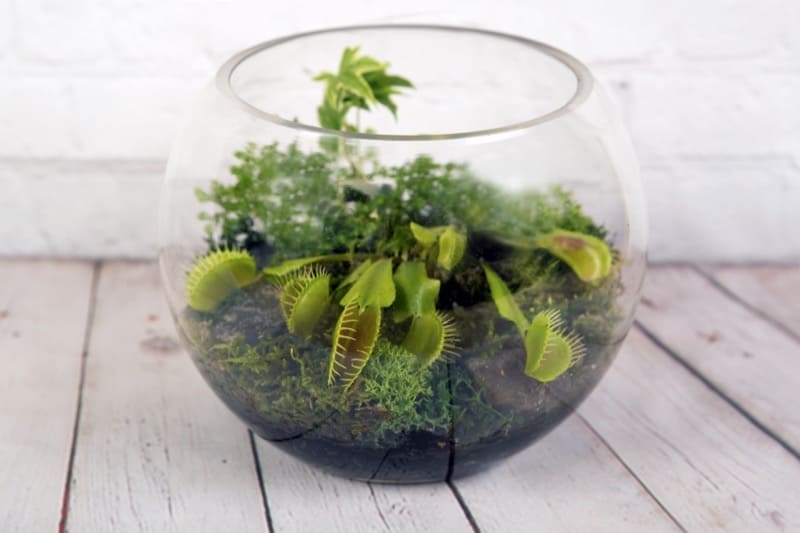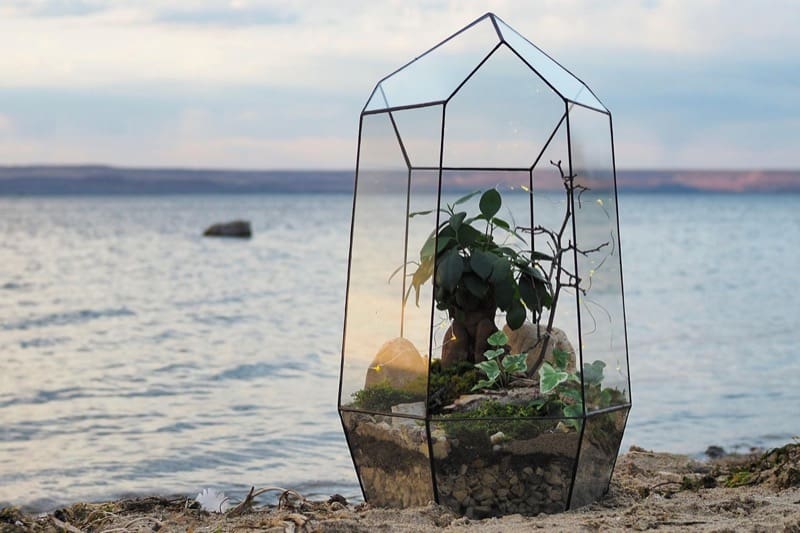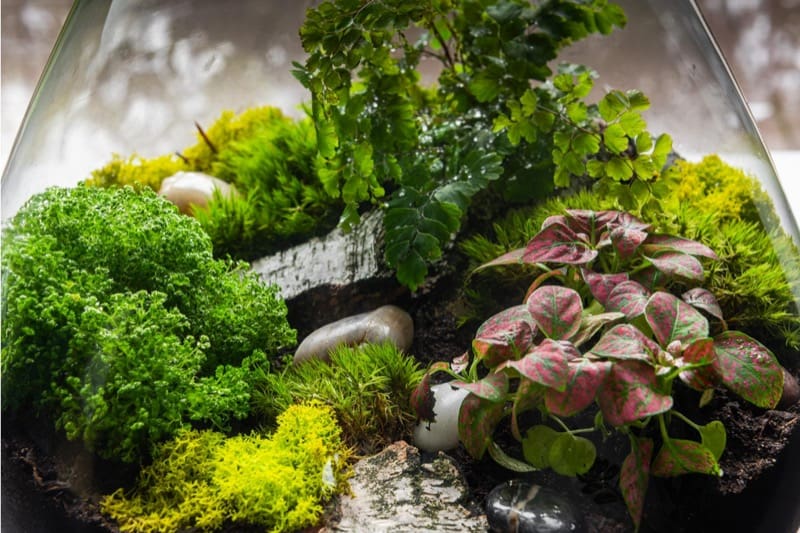While growing and showcasing a Venus Fly Trap in a terrarium may seem like a great idea, there are also some challenges and reasons not to. This doesn’t mean that it can’t be done successfully, but let’s consider everything involved in this choice.
From varied shapes, and trigger hairs, to slippery traps, there is an entire world of carnivorous plants to select from, with one of the most famous being the Venus Flytrap.
There is a good selection out there of carnivorous plants that work exceptionally well when cultivated in a terrarium, but not all carnivorous plants are created equal.
- Related: Are Venus Fly Traps Hard to Take Care of?
What they all share is the boggy environment they call home with few nutrients in acidic soil. The soil is poor to the point that they have evolved into carnivorous plants in search of other nutrition sources.
This article will cover the Venus Flytrap terrarium, the challenges of growing the plant in a terrarium, and how to make your own terrarium to grow the Venus Flytrap.

Should You Use a Venus Flytrap Terrarium?
Can Venus fly traps live in a terrarium and still grow well? Yes, but with extra care.
Terrarium conditions are usually hot and humid, making them ideal for carnivorous plants like Pitcher Plants or Sundews that thrive in tropical environments.
But the Venus Flytrap is a temperate plant, meaning it is one of the least suited plants for cultivation in a terrarium and the challenges to doing so, may outweigh the benefits.
For starters, Venus Flytraps are not fans of the high humidity or the high heat found in terrariums, and they die back in the winter.
The Venus Fly Trap Terrarium: Main Care Challenges
There are several care challenges when it comes to cultivating Venus fly traps in terrariums.
This is a higher maintenance plant with particular requirements for heat, humidity, light, soil, and water, that will condition wherever and however you choose to cultivate it.
Consider that this plant’s natural habitat is found in North and South Carolina, and grows within a one hundred-mile radius of Cape Fear. It is limited to such a small geographical area and explains how specific its needs are.
Learning proper Venus fly trap terrarium care will make growing Venus fly traps in terrariums a breeze.
Light and Heat – Managing the Levels
Be sure to load your Venus fly trap terrarium with light.
During their growth period, the Venus Flytrap requires lots of sunlight. Ideally, they should have approximately ten hours of sunlight daily, with four hours being the bare minimum. The Venus Flytrap needs lots of light and herein lies a principal challenge.
Exposing a terrarium to direct sunlight will increase the heat within it, and if exposed long enough in strong light, this will scorch plants. This is the main reason that closed terrariums are generally not exposed in bright direct light, but positioned in bright indirect light.
If you want to grow your Venus Flytrap in a terrarium, opt for artificial light that is sufficiently strong. Use it during your plant’s growing season.
Humidity – Should the Terrarium be Open or Closed?
Venus Flytraps do not require high humidity. Avoid closed terrariums for cultivation due to the risk of high humidity.
Venus Flytraps are much happier in an environment with humidity of around 50%, like most popular houseplants. They will tolerate environmental humidity as high as 70%, but this humidity level can prove to be risky if the humidity creeps up more.
A closed terrarium maintains a high humidity level, meaning that in no time at all, your Venus Flytrap might suffer damage. Your best option is to select an open terrarium that offers you sufficient height to guarantee that your plant will have good drainage.

Soil – Using the Right Soil for Terrariums
Venus Flytraps do not absorb their nutrition through their root system, but rather make their food through photosynthesis, and absorb nutrients from the prey they catch and digest.
Their roots and rhizomes are not intended for nutrient absorption. Because of this characteristic, the soil or substrate you use in a terrarium should be poor in nutrients. It’s most similar to the poor soil formations that are nutrient-free, in the bogs found of their natural habitat.
One of the challenges that gardeners face when using terrariums is soil compaction that occurs more rapidly. As soil compacts, mineral deposits develop, which will create a problem for the Venus Flytrap.
The terrarium substrate also needs to be exceptionally well-draining, and yet retain sufficient moisture. Again, the bogs found in their natural habitat are consistently wet but not waterlogged, and your growing medium in the terrarium must be also.
When selecting the proper growing medium for the terrarium, look for a specialist substrate. Avoid standard Venus Flytrap soils, if they contain peat moss.
Cultivating your Venus Flytrap in a terrarium will also require you to repot or change the substrate every spring at the end of your plant’s dormancy. This is to ensure that the soil is always nutrient-free. It will also aid in aeration and moisture retention. Do not repot your plant if flowering has already begun.
Learn more in this in-depth Venus Fly Trap Soil guide.
Feeding – Do I Need to Feed My Venus Flytrap?
There’s no need to feed a Venus Flytrap with fertilizer. They do fine on their own with sunlight and water, with their preferred diet of insects. So if you want to feed it, feed bugs to the Venus Flytrap.
When closed in a terrarium, they most likely do not have the same access to prey. This is another reason to choose an open glass dish.
You can feed your Venus Flytrap directly by inserting a fly or bug in its trap using a pair of tweezers. Higher nutrition levels will encourage growth.
- Related article: How Often to Feed a Venus Flytrap
However, take care to not set off the trigger hairs when you are not feeding your plant. Each flytrap will only open three to five times during its lifecycle, and each opening and closing requires an incredible amount of energy.
When traps are triggered for no reason, you are causing your plant to lose energy. If a plant loses too much, it will die.
- Related article: How and When the Venus Flytrap Opens and Closes
Water – What’s the Proper Watering for a Venus Flytrap Terrarium?
Water, like the soil bed, should be nutrient-free and mineral-free. Tap water usually contains a number of minerals and can cause harm. It’s best to use rainwater, distilled water, or reverse osmosis water.
Another challenge presented by terrarium cultivation is that it does not drain as an open pot with drainage holes would.
Create a sizable substrate layer for drainage. You will need to monitor water constantly because your plant must not sit in excess water that the substrate can absorb. Also, water your plant at its base and not overhead where water will drizzle over the leaves.
Learn more in the guide on How to Water Your Venus Fly Trap.
Dormancy – Caring for a Venus Flytrap in Winter Months
Venus Flytraps sleep in the winter months during its dormancy period. They enter a period of dormancy that lasts from October through February. Their natural habitat is cooler in this period.
The soil substrate will need to remain moist during dormancy and you can expect the foliage to die off. Dead leaves should be removed.
One challenge will be lowering the temperature within a terrarium enough for your plant to enter dormancy. When using an open terrarium, make sure your plant is placed in a location where the temperature measures between 32 ° and 50° Fahrenheit to ensure it rests.

Essential Items Needed for Making a Venus Flytrap Terrarium
Here are the items necessary for a carnivorous plant terrarium:
- An open terrarium – glass container, large bowl, fish tank
- Gravel or Leca
- Venus Flytrap potting medium
- Hardscape decorating elements
- Paintbrush or mini gardening utensil
- Venus Flytrap plant
- Distilled water
- Artificial grow lights
- Misting bottle
How to Make a Venus Fly Trap Terrarium
Step 1. Clean Your materials thoroughly
Clean your terrarium, gravel, and hardscape. Remove dirt, dust, and minerals.
Step 2: Prepare the Growing Medium
Fill the bottom of the terrarium with an inch or two of gravel or Leca for drainage. Place more in the area where you plan to plant your Venus Flytrap. Add in the potting medium.
Use your utensil or paintbrush to create your Venus fly trap substrate architecture of contours. Add in your decorating elements if you have any.
Step 3: Wet the Substrate and Plant
Using your misting bottle with distilled water, spray the substrate until it is evenly dampened. Use the end of the utensil, paintbrush, or similar to create a hole in the potting medium.
Remove your Venus Flytraps from their containers and gently remove any substrate around the roots. Position them in the holes you have fashioned. Exercise extreme caution when moving them to avoid triggering traps.
Once positioned, move the soil around the plant base to secure it.
Step 4: Prepare Your Terrarium Care
Set the grow lights on high and place your terrarium underneath them. If the lights have a timer, set it for eight to ten hours daily.
When October arrives, your plant should be moved to a cooler location where the temperature measures between 32° and 50° F for four months. Reduce the light level during these four months.
Best Venus Fly Trap Terrarium Ideas and Tips
Creating a terrarium for a Venus flytrap offers an opportunity to not just cultivate a plant, but to design a miniature ecosystem. Here are some top ideas for your Venus fly trap terrarium setup:
1. The Classic Bog: This setup emulates the Venus flytrap’s natural habitat. Use sphagnum moss as a base and consider adding other carnivorous companions like sundews or pitcher plants. A few rocks or driftwood pieces can provide a touch of realism and contrast.
2. The Minimalist’s Dream: If your aesthetic leans towards the clean and simple, this is for you. Place a single Venus flytrap in a sleek, modern terrarium. The unique, alien-like beauty of the plant becomes a striking focal point.
3. Tropical Wonderland: Combine Venus flytraps with other tropical plants that can thrive in similar conditions, such as certain ferns, mosses, or bromeliads. This creates a lush, vibrant backdrop for the flytraps.
4. Unexpected Combinations: Try pairing Venus flytraps with succulents that can tolerate higher moisture levels, such as certain types of Haworthia. The contrast between the fleshy succulents and the carnivorous flytraps can be visually intriguing.
5. Enchanted Forest: Ideal for the whimsically inclined or for children, this setup includes miniature fairies, toadstools, tiny bridges or any other fairy-tale elements. The Venus flytrap adds a dash of the extraordinary to this magical mini-world.
Regardless of your chosen theme, Venus flytraps have specific care needs. They require plenty of light, nutrient-poor soil, and pure water (distilled, rainwater, or reverse osmosis).
Make sure the terrarium is placed somewhere bright, and avoid fertilizers and tap water. With the right care, your Venus flytrap terrarium can become a thriving, fascinating addition to your home or office.
Lastly, let the flytrap be the star. Its unique, jaw-like traps are a natural centerpiece.
Terrarium Venus Fly Trap Care Final Thoughts
Creating a DIY terrarium for Venus fly trap plants is fun and rewarding for these wonderful plants. The best part is that you can create your own designs, changing up the colors, shapes, and sizes of decorations in the closed environment
Read more about Venus Flytrap plants in these articles:




